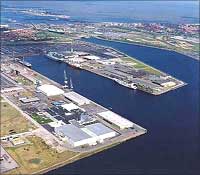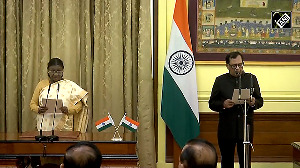 The next time you step into the leather-scented comfort of a newly acquired imported car, pause for a second to consider the story of how it came to be in your hands. This is a tale of crossing stormy oceans in the hold of mammoth deep-sea carriers. And more often than not, it also involves a call at the little-known Belgian port of Zeebrugge.
The next time you step into the leather-scented comfort of a newly acquired imported car, pause for a second to consider the story of how it came to be in your hands. This is a tale of crossing stormy oceans in the hold of mammoth deep-sea carriers. And more often than not, it also involves a call at the little-known Belgian port of Zeebrugge.
Strategically located on the coast of the North Sea, on the axis of the maritime traffic routes between the United Kingdom and the European continent, Zeebrugge has emerged as the world's womb for new cars. Over 2.1 million cars passed through its docks in 2008.
It has taken this upstart port less than two decades to challenge the established heavyweights in the region, Antwerp and Rotterdam, and emerge as the preferred port of call for all the big names in the auto logistics industry. Toyota, for example, has made the port its European hub, moving around 400,000 cars through it annually.
Wallenius Wilhelmsen Logistics, one of the world's leading car shippers, is another important player to have embraced Zeebrugge. It has 400 sailings a year to and from the port. William Van Dessel, managing director of the company's Zeebrugge operations, explains that the new port's popularity has emerged from a combination of its ideal location and the room it has for the new development.
Unlike Antwerp or Rotterdam, Zeebrugge is located on the sea, so that ships do not have to navigate up rivers to reach it. And unlike the older ports, Zeebrugge has ample land available for expansion. This has proved to be especially important, given the boom in shipping that has seen container volumes between Asia and Europe double over the past five years. Ships deployed on the route today are two-and-a-half times the size of the largest, a decade ago.
Moreover, the once relatively simple task of shipping new cars has grown enormously complex with the fragmentation of trade routes and the entry of new players. Only 15 years ago, auto shipping was confined to the movement of cars on three main routes - from Japan and South Korea to Europe, from the same countries to the United States and the transatlantic crossing between Europe and North America. Car production sites were mostly either near the sea or linked to ports by well-established logistics chains.
Today, there are not only a range of new players from China's Cherry to India's Tata, but a number of established manufacturers have also chosen to move production to lower-cost bases, in Asia, Africa and South America. Route networks are thus far more complex and production sites often far away from the coast, in countries still struggling to build modern infrastructure.
At Zeebrugge, WWL leases a 4.7 hectare terminal that houses both pre-delivery inspection and vehicle personalisation centres. Here cars can avail of a body shop, a car wash and also be modified to suit customer tastes.
Zeebrugge and WWL are currently attempting to replicate their success thousands of kilometers east, in India. The Flemish port signed an MoU with the port of Chennai in November last year, pledging technical assistance to help the south Indian port meet its goal of moving away from the handling of dirty goods like iron ore to clean cargo like containers and cars.
In the meantime, WWL has signed an agreement with Mundra port in Gujarat to assist it in setting up a dedicated auto terminal. Mundra, India's largest private port, wants to establish itself as the Zeebrugge of the East. Maruti is also investing Rs 40 crore towards a dedicated car terminal and PDI centre at the port. Already in January this year, a pilot consignment of 1,534 Maruti Suzuki A-Star cars, left for Europe from Mundra.
But despite all this stepped-up activity, the cold reality is that India's ports are woefully under-prepared for any significant movement of cars. Eric Maurissen, founder of WWL's Zeebrugge operations went to India in 2007 to carry out a port study on behalf of EUKOR (Europe Korea Car Carriers). He says he was sorely disappointed with what he saw.
"In Chennai, the port authorities claim they are serious about cars but in fact all their expansion plans until 2025 only focus on containers, containers, containers. Specific plans for cars are nowhere."
"It's strange," he continues. "On the one hand you (India) are promoting the cheapest car in the world (the Nano), but on the other hand there is no attempt to develop a long-term strategy to get these cars out to the world."
Maurissen says Chennai was keen for EUKOR to set up operations there, but the port lacked any room for expansion. "The port said it can provide space for up to 450,000 cars. That's a good beginning. But what happens afterwards? There are quick fix solutions but no strategy."
This judgment is borne out by the fact that only a couple of months ago, Hyundai Motor India Limited announced it will be looking to shift the production of its premium compact car, i20, from Chennai to Europe. One of HMIL's main complaints is the lack of port infrastructure to support surging exports.
HMIL is India's largest car exporter and is currently enjoying bumper sales in Europe as a result of incentives being offered by many European governments to people exchanging their old cars for new fuel-efficient ones. The company recorded a 33 per cent growth in exports year-on-year in June. But the lack of facilities at Chennai port is hampering its ability to keep up with the increased demand. Maurisson sums it up: "India needs to understand: if you want to sell cars, you first need to ship them."






